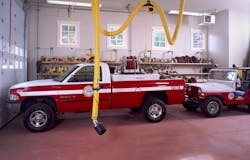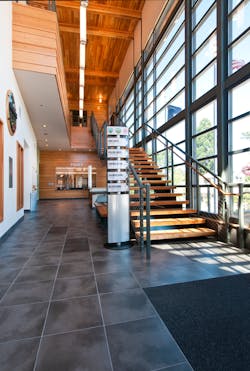Durable, Low-Maintenance Fire Station Flooring and Wallcoverings
Fire stations are operations-driven buildings. Each space within a station is designed for a specific function and is meant to be efficient, low maintenance and durable.
As an architect, I am asked by clients to specify the most durable materials for their station. Durability can be measured by the years that a material is expected to last and by the material’s capability to stand up to strenuous daily use.
The best low-maintenance materials typically also turn out to be the highest in quality and longevity. By definition, low-maintenance materials require minimal daily attention and upkeep. Furthermore, they tend to be natural materials, such as concrete, slate, clay and copper, to name a few.
Can the lowest-cost investment yield the best performance in durability and low maintenance in flooring and wallcoverings for a fire station? The short answer is yes.
One of the most durable flooring types is terrazzo. Terrazzo flooring is formed using chips of marble, granite, quartz and glass, which are held together by a cement or epoxy compound. Metal strips are used to create sections, make color transitions, design decorative patterns or logos, and allow for movement and crack mitigation. Installation typically includes a full mortar bed with one-half to three-quarters of an inch of chipped materials, which are polished to a desired slip-resistance and sealed to prevent staining. Once they are installed, terrazzo floors can take a lot of daily foot traffic and require only sweeping and wet mopping to maintain their appearance and cleanliness.
Although terrazzo is a durable, low-maintenance choice for flooring, it isn’t the least expensive choice. Laying terrazzo tile involves high labor and materials costs. Although an argument can be made that terrazzo flooring has excellent life cycle cost value, the cost that’s incurred for installation can be prohibitive.
In today’s modern fire stations, we can find polished concrete floors used in place of terrazzo. An everyday slab of grade concrete can be transformed into a highly durable and low-maintenance polished floor. Polishing concrete floors involves a grinding process to a desired depth to expose aggregates that are used in the concrete mix. The deeper the grind, the more aggregate is exposed, creating a terrazzo-like look. The grinding can create texture and slip-resistance. Applying a concrete hardener and waterproof sealant protects the polished concrete floor from water intrusion and staining.
Adding an integral color to concrete floors—whether you polish them or not—is a great, inexpensive way to enhance their appearance. Integral color is a blended oxide pigment that comes in dry and liquid forms that is combined with the concrete mix in the truck prior to placement. Integral color is consistent throughout the entire thickness of the concrete slab and is fade-resistant. These floors should have a broom or troweled finish to provide a nonslip surface.
Another way to enhance appearance: acid stains, both for a polished, integral-colored concrete floor or a plain concrete floor. Because acid stains penetrate the surface layer of concrete, they can create a unique, eye-catching pattern(s).
Acid stains are durable and fade-resistant but, unlike integral color, aren’t consistent throughout the concrete slab. Concrete surfaces that are acid-stained can be slippery when they are wet, particularly if the stain has a high-gloss sealer.
Exposed concrete floors have different price points, with sealed plain concrete being at the lower end and acid-stained and integral-colored being at the higher end.
Epoxy flooring systems are based on a combination of resins and hardeners. When these materials are mixed together, the resin and hardener chemically react to form a rigid plastic material that is then applied to a concrete slab. Epoxy finishes take a long time to harden, and they can be slippery when wet. Texture is needed to create slip-resistance. Epoxy floors are very rigid, so slight shifts in the foundation or concrete slab could lead to cracks forming in the epoxy coating. These cracks are difficult to repair without recoating the floor with a new layer of epoxy, which is an expensive proposition. Epoxy flooring is in the medium-to-high cost range.
Rubber flooring typically is available in square tiles that can be cut into different sizes and shapes. It’s extremely durable, low maintenance and in the low-to-medium range for costs. A softer material, rubber is perfect for exercise rooms.
Linoleum, vinyl, carpeting
Real linoleum is made from all-natural materials, including wood flour, resins, ground limestone, powdered cork, pigments, jute and linseed oil. Linoleum comes in sheet and tile forms. It’s a flexible material that’s durable and moisture resistant. Although low maintenance, linoleum can be scratched, and it is higher in cost than other sheet or tile flooring. Modern vinyl flooring comes in sheet and tile forms, too. It’s composed of colored polyvinyl chloride (PVC) chips, which are formed into solid sheets of varying thickness (one-eighth inch is the most common thickness) by heat and pressure. Vinyl flooring is low maintenance and durable and delivers a low cost model.
In the past 20 years or so, fire stations have moved away from using carpet as frequently as they once did. Carpet requires daily maintenance by vacuuming and regular cleaning. It isn’t stain-resistant, and its durability is low compared with that of other flooring types. Furthermore, carpeting captures dirt and contaminates. Carpet tiles, also known as modular carpets or square carpets, are squares cut from wall-to-wall carpet rolls, which can be fitted together to make up a carpeted area. Carpet tiles can be individually replaced if there is staining or damage.
Wallcoverings
Durable and low-maintenance interior wallcoverings help to protect walls in high traffic and impact environments.
Impact-resistant drywall (gypsum) panels consist of a high-density, mold-and-moisture-resistant, Type X core that’s covered both front and back in either heavyweight-paper facers or tough fiberglass mats. Once it is put in place, impact-resistant drywall along hallways helps in regard to wall finish longevity. The drywall material is textured and painted and looks like any other wall. This is a low-maintenance and durable solution for fire stations, particularly when impact-resistant drywall is paired with corner guards and wainscotting. That said, impact-resistant drywall is more expensive than conventional drywall.
Fiberglass reinforced panels (FRPs) are thin and flexible and made of strong polyester resin that’s reinforced with fiberglass. The panels are used on walls and ceilings to protect the finish, and they can be installed directly over drywall, concrete masonry units (CMUs) and other types of solid wall surfaces. FRPs are great for use in apparatus bays, apparatus support spaces and restrooms. Not only is FRP durable and low maintenance, but its in the low-to-medium cost range.
CMU is made from portland cement, aggregate and water. As a building wall material, concrete offers a wide variety of finishes and colors. Once the exposed CMU is sealed—producing both the structural wall and wall finish—it provides substantial durability and low maintenance.
Full-dimensional brick, thin-brick veneer and structural brick blocks can be used as a finished wall material. Structural brick block is similar to CMU. Once exposed brick is sealed, the finish of the wall is very durable and low maintenance.
Porcelain and ceramic tile
Porcelain is made from very fine clay that is fired at high temperatures to remove moisture from the tile, which results in a very hard and dense tile. The density of porcelain tile makes it ideal for high traffic areas and restrooms.
Ceramic tile is made from natural clay, sand and water. These materials are molded to form tiles, which are baked in a kiln to remove the moisture.
Both of these materials are set in a full mortar bed for flooring and can be full or thin set for wallcovering. Porcelain and ceramic tile, which can be used for flooring and wallcoverings, are very durable. However, because tile has grout lines, it is high maintenance. The cost range of porcelain and ceramic tile goes from low to high. The color and finish of tile is what dictates pricing.
When working through all of these choices with your architect, you can evaluate the benefits and challenges of each flooring and wallcovering material in regard to your budget and operational needs.
Refurbishing Existing Concrete Floors
Concrete floors of all types can be refinished easily to look as good as new. If you are looking to renovate or replace flooring, you simply can remove the existing flooring to expose the existing concrete slab. Stains or polishing could be implemented to provide a new and durable surface.
The existing concrete should be fine to stain as long as all glues, paints, oils, grease, sealers, waxes or anything else that would prevent the stain from soaking into the pores of the concrete are removed. Hardening and sealing is recommended for all newly exposed concrete floors.
About the Author
Candice Wong
Candice Wong, LEED AP, is a principal at Ten Over Studio, where she leads the Public Safety Studio. She has dedicated the past 23 years of her career to helping first responders to live and work in operations-driven, holistic, comfortable facilities. Wong is a leader on how to marry good design, strong technical documents and sustainable solutions.


